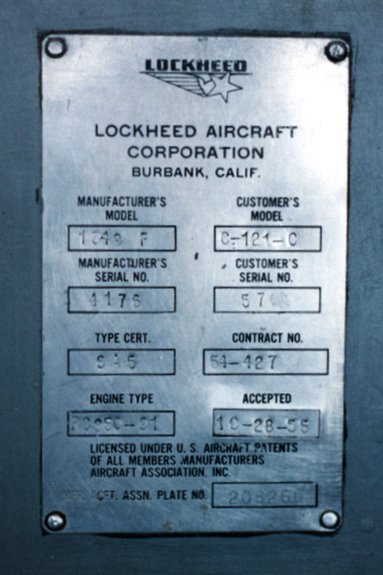Qantas Connie Model Numbers
-
What do they mean?
749-79-31
Here is one of the more complicated numbers:
1049E/01-55
QANTAS
CONNIE MODELS
| ||||||||||||||||||||||||||||||||||||||||||||||||||||||||||||||||||||||||||||||||||||||||||||||||||||
|
Version
|
Description
|
MTOW
|
|
749
|
Original version of the Constellation delivered to Qantas. |
102,000
lb.
|
|
749A
|
Strengthened landing gear to permit increased MTOW. |
107,000
lb.
|
|
1049C
|
Original version of the Super Constellation delivered to Qantas. |
133,000
lb.
|
|
1049E
|
Fuselage and wing reinforcements to allow for future fitment of turbo prop engines. |
133,000
lb.
|
|
1049E/01
|
Post-delivery upgrade of 1049E with strengthened landing gear to permit increased MTOW. |
135,400
lb.
|
|
1049G/02
|
Post-delivery upgrade of 1049C, 1049E, 1049E/01 to 1049G. |
137,500
lb.
|
|
1049H
|
A 1049G passenger/cargo version with the fuselage and freight doors of the military 1049F/C-121C. |
137,500
lb.
|
(MTOW = Maximum Take-off Weight)
QANTAS
CONNIE ENGINE TYPES
|
Version
|
Engine
|
Aircraft
|
|
79
|
Wright 749C18-BD1 |
749,
749A
|
|
55
|
Wright 972TC18-DA1 |
1049E
|
|
82
|
Wright 972TC18-DA3 |
1049E,
1049E/01, 1049G, 1049H
|
QANTAS
CONNIE INTERIOR VERSIONS
|
Version
|
Type
|
Seats
|
Year
|
|
31
|
749, 749A |
42
|
1947
|
|
81
|
1049C, 1049E |
63
|
1951
|
|
118
|
1049E |
59
|
1953
|
|
119
|
1049E/01 |
59
|
1953
|
|
133
|
1049H |
87
|
1955
|
|
140
|
1049E |
63
|
1956
|
|
153
|
1049G |
63
|
1957
|
| Note that the number of seats shown is a guide only as there were variations within each version (e.g. sleeper seats and day seats). Also note that these version numbers have little relevance after the aircraft left the factory as customers would adjust configurations as required. As an example, by 1959, Qantas was operating a 1049G with 82 seats. |
WHAT
THE L?
|
or nothing?
Lockheed themselves usually describe the aircraft as e.g.
"Model 1049". As it is Lockheed talking, stating
the company name again is superfluous. For other users,
it is necessary to mention the name of the manufacturer
and it is usually more convenient to use an abbreviation.
You will see all of the above commonly used by people
other than Lockheed to describe the Constellation series.
This writer has chosen to standardise on Ldash (specifically
an endash or hyphen, without spaces).
|
Sources
|
"The
Lockheed Constellation Series" by Peter Marson (Air-Britain)
1982
|
|
"Super
Constellation Pocket Handbook" Lockheed, September
1954.
|
| Issue | Date | Remarks |
|---|---|---|
| 1 | 24FEB16 |
Original
Issue
|



